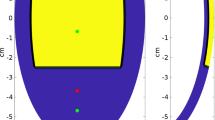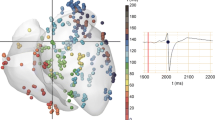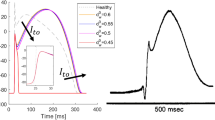Abstract
The aim of this work was to compare experimental investigations on effects of lidocaine, calcium and, BRL 34915 on reentries to simulated data obtained by use of a model of propagation based on the Huygens' constriction method already described in previous works. Calcium and lidocaine effects are investigated on anisotropic conduction conditions. In both cases, reduction in conduction velocities are observed. In lidocaine case, a refractory area is located along the longitudinal axis. In agreement with experimental electrical mapping, the simulations show that the stabilization of reentrant excitation is mainly due to the existence of this refractory area around which the reentrant circuit can develop. The experimental study shows that BRL 34915 has both arrhythmogenic and antiarrhythmic effects. A detailed electrophysiological analysis has shown that drug infusion act on normal cardiac cells by decreasing the relative and absolute refractory period. BRL 34915 action is simulated by a decrease in the refractory period showing that the time frequency of the reentrant activity is increased and that the spatial size where the reentry is developing is becoming smaller. These two effects are arrhythmogenic, the simulated data being so in good agreement with the experimental ones.
Similar content being viewed by others
References
Ahlfeldt H., H. Tanaka, M.E. Nygards, T. Eurukawa and O. Wigertz (1987). Computer simulation of cardiac arrhythmias. Comp. Biomed. Res. 20: 305–323.
Auger P., A. Bardou, A. Coulombe and J. Degonde (1987). Computer simulation of mechanisms inducing ventricular fibrillation. In IEEE Proceed. -CH 2519-, IEEE Computer Society, p. 171–174. Montréal.
Auger P., A. Bardou, A. Coulombe and J. Degonde (1988a). Computer simulations of different electrophysiological mechanisms of ventricular fibrillation. In Comp. in Cardiol. IEEE Computer Society, p. 527–530, Louvain.
Auger P., A. Bardou, A. Coulombe and J. Degonde (1988b). Computer simulation of ventricular fibrillation. Math. Comput. Modelling. 11: 813–822.
Auger P., A. Coulombe, M-C. Govaere, J-M. Chesnais, D. Von Euw and A. Bardou (1989). Computer simulations of mechanisms of ventricular fibrillation and defibrillation. Innov. Techn. Biol. Med. 10: 299–312.
Beeler G.W. and H. Reuter (1977). Reconstruction of the action potential of ventricular myocardial fibres. J. Physiol. 268: 177–210.
Bril A. and L. Rochette (1987). Comparison of the effect of antidepressant drugs on arrhythmias in the isolated rat heart subjected to myocardial ischaemia and reperfusion. Pharmacol. toxicol. 60: 249–254.
Cardinal, R., M. Vermeulen, M. Shenasa, F. Roberge, P. Page, F. Hélie and P. Savard (1988). Anisotropic conduction and functional dissociation of ischemic tissue during reentrant ventricular tachycardia in canine myocardial infarction. Circulation 77: 1162–1176.
Delmar M., J. Jalife and D.C. Michaels (1986). Effects of changes in excitability and intercellular coupling and synchronization in the rabbit sino-atrial node. J. Physiol. 370: 127–150.
Fitzhugh R. (1960). Thresholds and plateau in the Hodgkin-Huxley equations. J. Gen. Physiol. 43: 867–896.
Hodgkin A.L. and A.F. Huxley (1952). A quantitative description of membrane current and its application to conduction and excitation in nerve. J. Physiol. 117: 500–544.
Kaplan D.T., J.M. Smith, E.H. Saxberg Bo and R.J. Cohen (1988). Nonlinear dynamics in cardiac conduction. Math. Biosci. 90: 19–48.
Katoh, H., S. Ogawa, I. Furuno, Y. Sato, S. Yoh, K. Saeki and Y. Nakamura (1988). Potent electrophysiological effects of E-4031, a novel class III antiarrhythmic agent, on reentrant ventricular tachycardia. Suppelement II Cir. 78: 148.
Lambert, C., R. Cardinal, M. Vermeulen, D. Lamontagne, R. Nadeau, P. Paradis and J.L. Rouleau (1987). Lack of relation between the ventricular refractory period prolongation by amiodarone and the thyroid state in rats. J. Pharmacol. Exp. Ther. 242: 320–325.
Lorange M. and R.M. Gulrajani (1986). Computer simulation of the Wolff-Parkinson-White preexcitation syndrome with a modified Miller-Geselowitz heart model. IEEE Trans. Biomed. Eng. BME 33, 9: 862–873.
Noble D.A. (1962). A modification of the Hodgkin-Huxley equations applicable to Purkinje fibre action and pace-maker potentials. J. Physiol. 160: 317–352.
Rinzel J. and J.B. Keller (1973). Travelling wave solutions of a nerve conduction equation. Biophys. J. 13: 1313–1337.
Smith J.M. and R.J. Cohen (1984). Simple finite element model accounts for wide range of cardiac arrhythmias. US Nat. Acad. Sci. Pro. 81: 233–237.
Smith J.M., A.L. Ritzenberg and R.J. Cohen (1984). Percolation theory and cardiac conduction”. In Comp. in Cardiol., IEEE Computer Society, p. 175–178.
Van Capelle F.J. and D. Durrer (1980). Computer simulation of arrhythmias in a network of coupled excitable elements. Circ. Res. 47: 454–466.
Winfree A.T. (1987). When Time Breaks Down. The Three Dimensional Dynamics of Electrochemical Waves and Cardiac Arrhythmias. Princeton, Princeton University Press.
Author information
Authors and Affiliations
Rights and permissions
About this article
Cite this article
Auger, P., Cardinal, R., Bril, A. et al. Interpretation of epicardial mapping by means of computer simulations: Applications to calcium, lidocaine and to BRL 34915. Acta Biotheor 40, 161–168 (1992). https://doi.org/10.1007/BF00168145
Published:
Issue Date:
DOI: https://doi.org/10.1007/BF00168145




